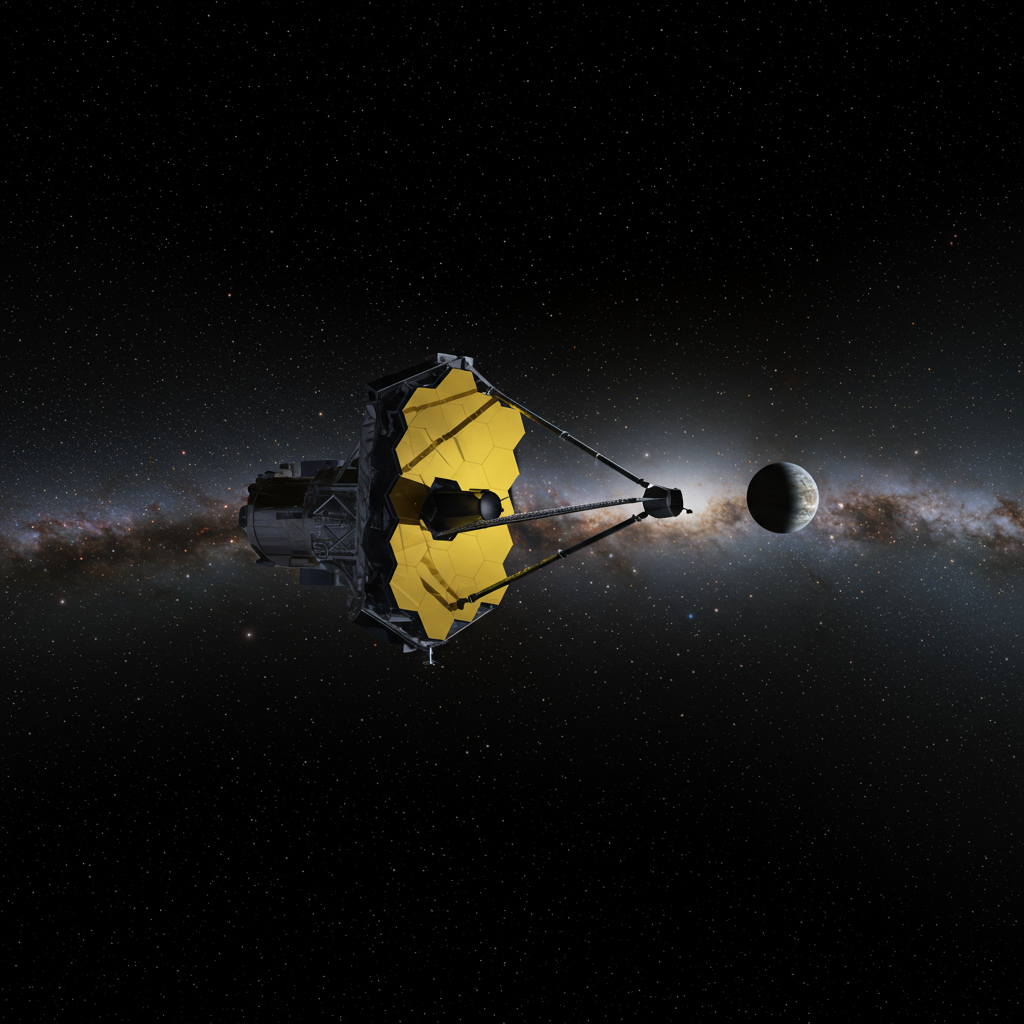In a landmark moment for astronomical observation, the James Webb Space Telescope (JWST) has successfully captured its first direct image of an exoplanet – a world orbiting a star beyond our sun. This groundbreaking achievement identifies a likely planetary candidate, dubbed TWA 7b, within a disk of debris surrounding a young star located approximately 111 light-years from Earth. The discovery provides unprecedented insights into the early stages of planetary system formation and highlights JWST’s extraordinary capability to directly image faint worlds hidden by stellar glare.
The Challenge of Imaging Distant Worlds
Finding planets outside our solar system, known as exoplanets, is incredibly difficult. While astronomers have discovered thousands using indirect methods – like detecting a star’s slight wobble caused by a planet‘s gravity or observing the dip in brightness as a planet passes in front of its star (transit method) – directly imaging these distant worlds presents a significant challenge. The core problem is the overwhelming brilliance of the host star. Imagine trying to spot a firefly hovering next to a powerful lighthouse from miles away; the star’s light completely drowns out the faint glow of the much smaller, dimmer planet. Most known exoplanets are found indirectly.
To overcome this, astronomers needed a way to block the intense starlight. The James Webb Space Telescope is equipped with specialized instruments designed for this very purpose.
Blocking the Glare: How JWST Sees Exoplanets
JWST employs a sophisticated tool called a coronagraph. Located within its Mid-Infrared Instrument (MIRI), this attachment acts like a tiny artificial eclipse, physically blocking the light from a target star. This allows the telescope to detect the much fainter light emanating from objects orbiting nearby, such as planets.
Young exoplanets are still relatively warm from their formation process, causing them to emit detectable amounts of infrared radiation. JWST is exceptionally sensitive to infrared light, making it ideally suited to spotting these nascent worlds. By combining the light-blocking power of the coronagraph with JWST’s infrared sensitivity, researchers can isolate the heat signature of an orbiting planet, even when it’s positioned close to its bright star.
Unveiling TWA 7b: A Young, Saturn-Mass World
The target of this particular observation was the star TWA 7, also known as CE Antilae. This is a very young star, estimated to be only a few million years old – a mere infant compared to our sun’s 4.6 billion years. TWA 7 resides within a fascinating system that includes a prominent debris disk composed of dust and rocky material leftover from its formation.
The potential exoplanet, TWA 7b, is estimated to be around the mass of Saturn. This makes it significantly lighter than any exoplanet previously captured through direct imaging. Earlier direct imaging discoveries typically involved much more massive gas giants, often many times the mass of Jupiter. TWA 7b, at roughly 0.3 times Jupiter’s mass (or approximately 100 Earth masses), is about ten times less massive than the previous record holder for a directly imaged exoplanet. This showcases JWST’s unprecedented ability to detect lower-mass worlds directly.
Initial observations suggest TWA 7b is still quite warm from its formation, with an estimated temperature around 120 degrees Fahrenheit (roughly 50 degrees Celsius). It orbits its host star at a considerable distance, estimated to be about 50 to 52 times the distance between Earth and the sun. This wide orbit contributes to its long orbital period, likely spanning several hundred years. While there’s a very small chance the detected infrared source could be a background galaxy (estimated at less than 0.4%), the evidence strongly points to a planet.
TWA 7b: The First Directly Imaged “Shepherd” Planet
The TWA 7 system has long intrigued astronomers, partly because its debris disk is seen “pole-on” from Earth. This provides a unique, face-on view of the disk’s structure. Previous observations, including data from instruments like ESO’s Very Large Telescope (VLT), revealed that this disk is not uniform but structured into distinct rings with empty lanes or gaps between them. Astronomers have long theorized that these gaps are carved out by the gravitational influence of orbiting planets, like celestial “shepherds” clearing a path through the dust and debris.
The JWST image detected the faint infrared source identified as TWA 7b located precisely within one of these narrow rings and associated gaps. This observation provides the first clear empirical evidence of a planet directly associated with sculpting the structure of its surrounding debris disk in this way. Scientists ran computer simulations based on the detected planet’s mass and position. These simulations showed that a planet like TWA 7b, located at that distance, would indeed carve out the observed narrow ring and the adjacent empty lanes in the disk. The close alignment between the simulations and the actual JWST observations solidified the researchers’ confidence that they had found the planet responsible for shaping the disk.
This discovery is particularly exciting because it directly supports the “shepherd planet” theory, which was previously based on indirect evidence from disk structures alone. Seeing the planet in situ within the gap it created is a major validation of these theoretical models.
A New Era for Understanding Planet Formation
Studying young star systems like TWA 7 offers astronomers a unique opportunity to witness planetary systems in their formative years. Debris disks are essentially the remnants of the planet formation process – leftover material that didn’t coalesce into planets. Their structure acts as a historical record, providing clues about the processes that occurred as planets were born and how they interact with their environment.
The ability of JWST to directly image a low-mass planet like TWA 7b in such a young system opens a critical new window into planet formation. Previously, direct imaging was mostly limited to older, more massive, and often wider-orbiting planets. Detecting a Saturn-mass planet influencing its disk at this early stage allows scientists to test and refine their models of how planets grow, migrate, and shape their surroundings. Understanding the diversity of planetary systems and how they evolve is a fundamental goal of astronomy, and discoveries like TWA 7b are crucial steps toward achieving that goal. The insights gained from this young system can ultimately help us better understand the history and formation of our own solar system.
JWST’s Power and Future Potential
This first direct image discovery by the James Webb Space Telescope underscores its unparalleled capabilities for exoplanet research. Its combination of high-resolution imaging, sensitivity to infrared light, and the coronagraph instrument positions it as a premier tool for directly observing worlds beyond our sun, especially those that are younger, lower in mass, or closer to their stars than previously detectable.
The success in imaging a relatively low-mass world like TWA 7b suggests that JWST is capable of finding even lighter planets. Researchers are planning further observations of the TWA 7 system, potentially including studies of TWA 7b’s atmosphere using other JWST instruments. This discovery marks just the beginning of what JWST is expected to reveal about the exoplanet population through direct imaging, promising many more exciting findings as it continues to explore distant star systems.
Frequently Asked Questions
How did the James Webb Space Telescope capture a direct image of this exoplanet?
Directly imaging an exoplanet is difficult due to the host star’s blinding light. JWST used a special tool called a coronagraph on its Mid-Infrared Instrument (MIRI). This instrument blocks out the star’s light, allowing the telescope to detect the faint infrared heat signature emitted by the young planet, TWA 7b, making it visible against the dark background created by blocking the star.
Where is the exoplanet TWA 7b located, and how old is its star system?
The exoplanet TWA 7b orbits the star TWA 7 (also known as CE Antilae), located approximately 111 light-years away from Earth. The TWA 7 system is considered very young in astronomical terms, with an estimated age of only a few million years. This youth makes it a prime target for studying the early processes of planet formation.
What makes the exoplanet TWA 7b discovery particularly important for understanding planet formation?
TWA 7b is significant for several reasons. It’s the lowest mass planet (Saturn-mass) ever directly imaged, demonstrating JWST’s power. Found within a gap in its star’s debris disk, it’s the first directly observed “shepherd” planet responsible for clearing such a gap. Studying this young system shows how low-mass planets interact with disks early on, providing crucial data to refine models of planet formation, including how our own solar system formed.
Conclusion
The James Webb Space Telescope’s success in capturing the first direct image of an exoplanet marks a pivotal moment in our search for worlds beyond our solar system. The identification of TWA 7b, a Saturn-mass planet actively shaping its young star’s debris disk, provides invaluable empirical evidence for theories of planet-disk interaction. This achievement, made possible by JWST’s unique infrared capabilities and coronagraph technology, opens a new window for directly observing lower-mass planets in their formative years. As JWST continues its mission, astronomers anticipate many more discoveries that will fundamentally reshape our understanding of how planetary systems, including our own, come into being.
Word Count Check: 1121




